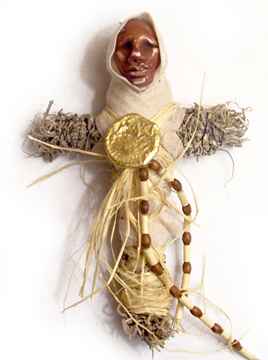The ancient Greeks often used sympathetic magick in love or defensive spells. Christopher Faraone, Professor of Classical Languages and Literatures at the University of Chicago, is one of the foremost authorities on Greek magick today. Faraone states that Greek poppets, called Kolossoi, were sometimes used to restrain a ghost or even a dangerous deity. They could also be used to bind two lovers together.
The Greek tragedian Theocritus refers to melting and burning wax dolls in Idyll 2, The Witch (Pharmakeutria), which was written around 270 b.c. He describes the ways in which Simaetha, who has been dumped by her lover, Delphis, attempts to lure him back to her with magic. At the same time, she tries to make him forget any woman who might be a potential rival. Simaetha was quite a busy girl.
The idea of wax dolls has carried on throughout the centuries. When Caroline of Brunswick, Princess of Wales, was married to a perfectly awful gentleman who would become King George IV, she apparently spent many hours forming wax dolls of her husband and jabbing them with pins. There is no evidence as to the effect this may have had on George, but when Caroline decided to scamper off to a villa in Italy and shack up with her Italian lover, George didn't protest. The royal couple remained married but lived separately until Caroline's death in 1821.
In West African magick, a doll called a fetish is used. The doll is actually possessed by spirits, and represents the spirit to the doll's owner. The fetish contains magickal power, and is carried by its owner either on the body or as an amulet. Slave owners in North America were permitted to hand out a death sentence to anyone found in possession of a fetish. Small wonder, considering that the owners didn't understand anything about African culture - and subsequently feared it.
In Voodoo itself, or Vodun, the use of poppet magick became popular in New Orleans after the end of the Civil War, although sources disagree as to whether poppets are used at all in Haiti, the home of the Vodun religion.
The Voodoo Museum of New Orleans even stocks a variety of dolls in their gift shop. This appears to be a bone of contention among practitioners, some of whom are trying to get away from the "serpent rite and pins-in-the-doll" rituals.
Source: Lynn and Patti
Poppet by knickertwists.com
Suggested e-books:
Joseph Ennemoser - The History Of Magic Vol 1Anonymous - The Basics Of Magick
Tags: collection book shadows complete guide craft tarjuman collection treatis great circle purification allergies book knowledge satanic rituals sefer yetzirah evocation anges heptarchia spiritual travels mysteriorum quintus appendice necronomicon hp lovecraft









